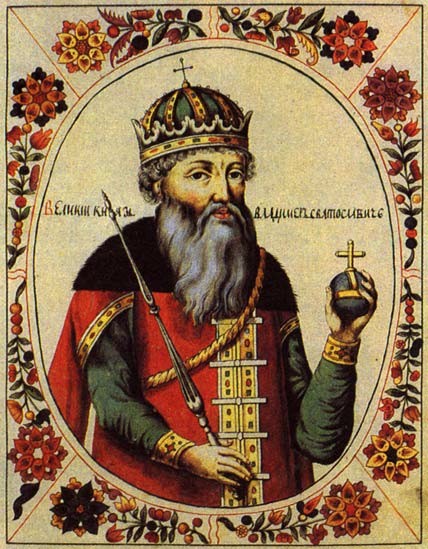Holy Great Prince Vladimir (Basil in Baptism), Equal of the Apostles, and Enlightener of Rus’

† Holy Equal-to-the-Apostles Great Prince Vladimir (in holy baptism Basil), enlightener of the Russian Land (1051)
Vladimir I
Vladimir I, also known as Vladimir the Great or Vladimir Sviatoslavich the Great, ruled Kievan Rus’ from 980 to 1015 and is famous for Christianizing this territory during his reign. Before he gained the throne in 980, he had been the Prince of Novgorod while his father, Sviatoslav of the Rurik Dynasty, ruled over Kiev. During his rule as the Prince of Novgorod in the 970s, and by the time Vladimir claimed power after his father’s death, he had consolidated power between modern-day Ukraine and the Baltic Sea. He also successfully bolstered his frontiers against incursions from Bulgarian, Baltic, and Eastern nomads during his reign.
Early Myths of Christianization
The original Rus’ territory was comprised of hundreds of small towns and regions, each with its own beliefs and religious practices. Many of these practices were based on pagan and localized traditions. The first mention of any attempts to bring Christianity to Rus’ appears around 860.
The Byzantine Patriarch Photius penned a letter in the year 867 that described the Rus’ region right after the Rus’-Byzantine War of 860. According to Photius, the people of the region appeared enthusiastic about the new religion and he claims to have sent a bishop to convert the population. However, this low-ranking official did not successfully convert the population of Rus’ and it would take another twenty years before a significant change in religious practices would come about.
The stories regarding these first Byzantine missions to Rus’ during the 860s vary greatly and there is no official record to substantiate the claims of the Byzantine patriarchs. Any local people in small villages who embraced Christian practices would have had to contend with fears of change from their neighbors.
Constantinople and Conversion
The Primary Chronicle (one of the few written documents about this time) states that in 987 Vladimir decided to send envoys to investigate the various religions neighboring Kievan Rus’.
Vladimir apparently wanted to unite the people under one religion, so around 988 he sent envoys to examine the major religions. The options? Islam, Judaism, the Catholic Christianity of Western Europe, and the Orthodox Christianity of Eastern Europe (though as yet, there was no official break between the Orthodox and Catholic Christians).
According to the limited documentation from the time, the envoys that came back from Constantinople reported that the festivities and the presence of God in the Christian Orthodox faith were more beautiful than anything they had ever seen, convincing Vladimir of his future religion.
Another version of events claims that Basil II of Byzantine needed a military and political ally in the face of a local uprising near Constantinople. In this version of the story, Vladimir demanded a royal marriage in return for his military help.
He also announced he would Christianize Kievan Rus’ if he was offered a desirable marriage tie. In either version of events, Vladimir vied for the hand of Anna, the sister of the ruling Byzantine emperor, Basil II. In order to marry her he was baptized in the Orthodox faith with the name Basil, a nod to his future brother-in-law.
He returned to Kiev with his bride in 988 and proceeded to destroy all pagan temples and monuments. He also built the first stone church in Kiev named the Church of the Tithes starting in 989. These moves confirmed a deep political alliance between the Byzantine Empire and Rus’ for years to come.
Baptism of Kiev
On his return in 988, Vladimir baptized his twelve sons and many boyars in official recognition of the new faith. He also sent out a message to all residents of Kiev, both rich and poor, to appear at the Dnieper River the following day. The next day the residents of Kiev who appeared were baptized in the river while Orthodox priests prayed. This event became known as the Baptism of Kiev.
The story of Vladimir’s choosing Orthodox Christianity is part legend, part fact. According to the tradition, Vladimir didn’t like the dietary restrictions of Islam and Judaism. Catholic Christianity was all right, but what impressed the grand prince was the dazzling worship his ambassadors described seeing in the great Cathedral of Hagia Sophia in Constantinople: “We knew not whether we were in heaven or on earth, for surely there is no such splendor or beauty anywhere upon earth. …”
Many local populations violently rejected the new religion and a particularly brutal uprising occurred in Novgorod in 1071. However, Vladimir became a symbol of the Russian Orthodox religion.
He reposed in peace in 1015-07-15 (28), leaving behind a kingdom that grew to be the largest Orthodox nation in the world.


